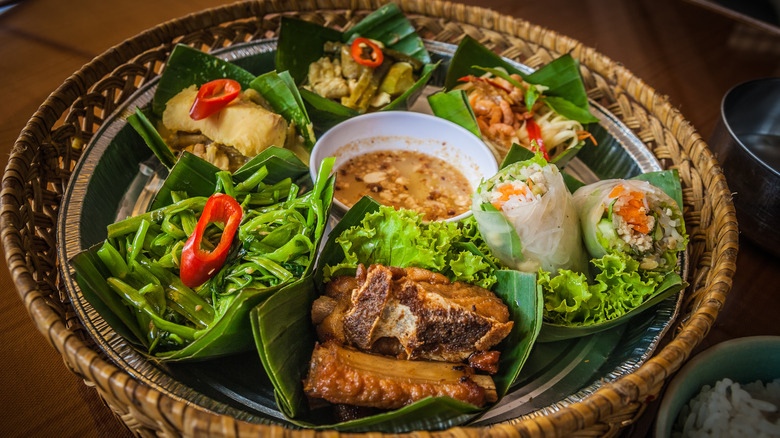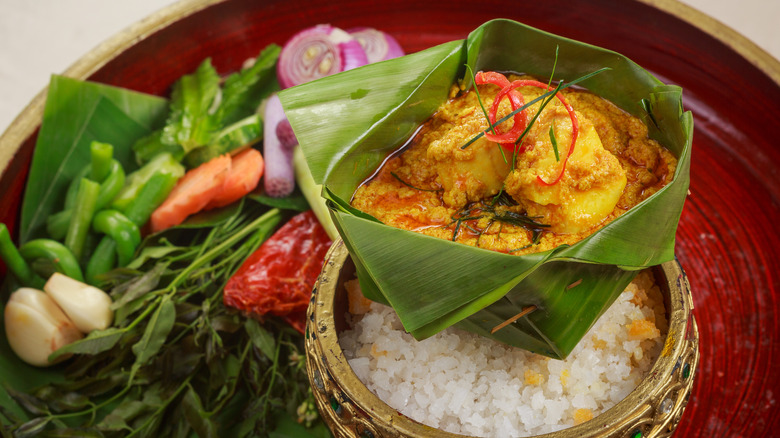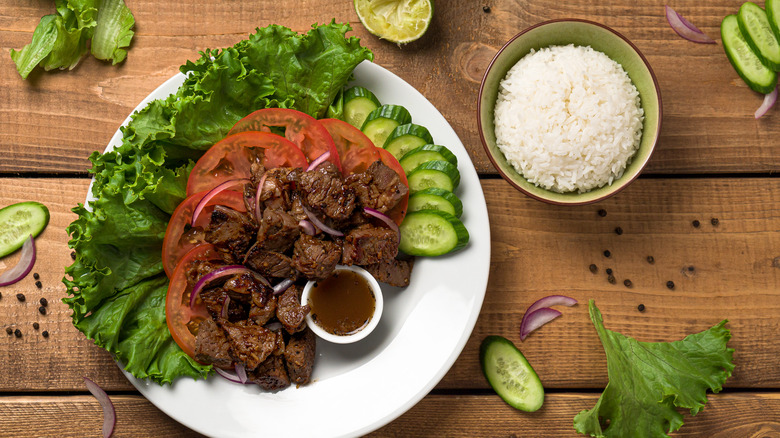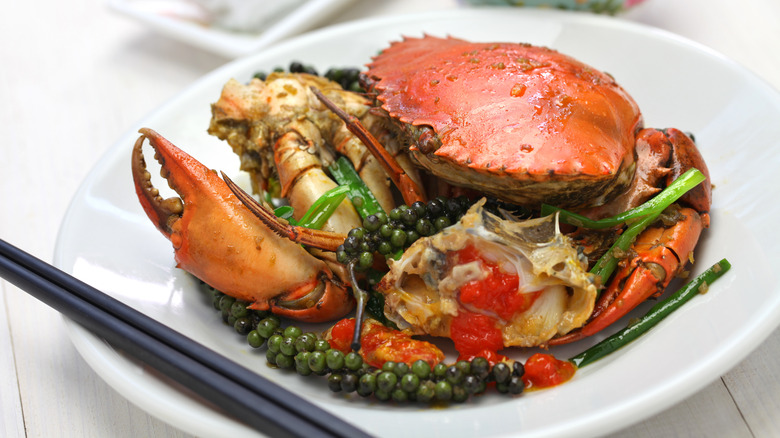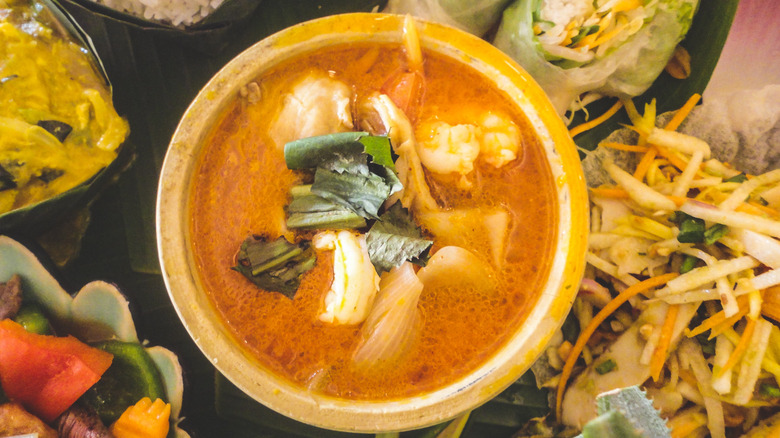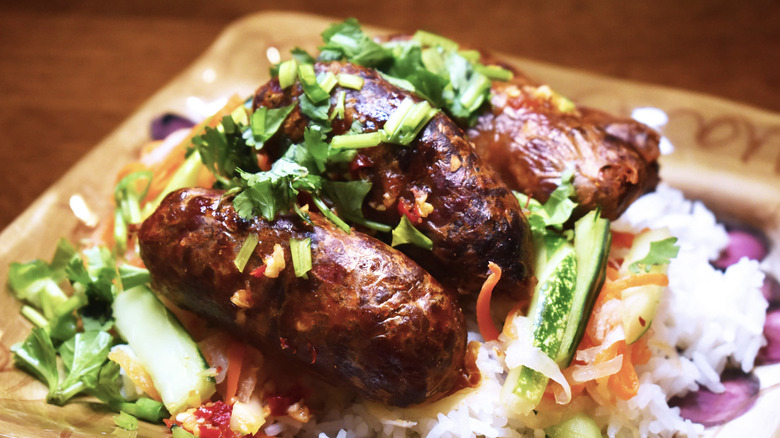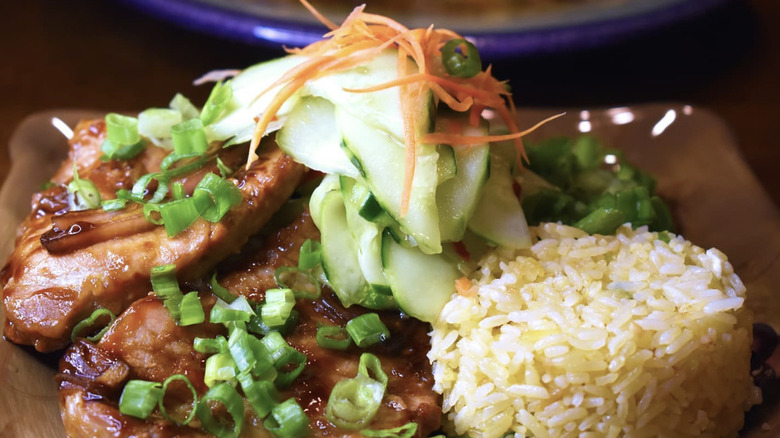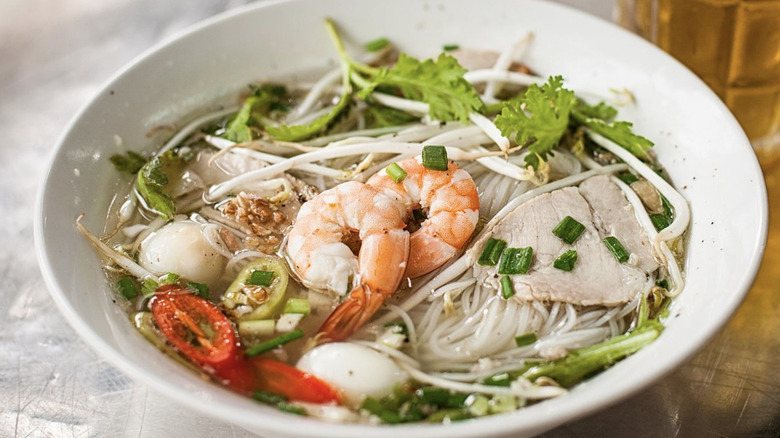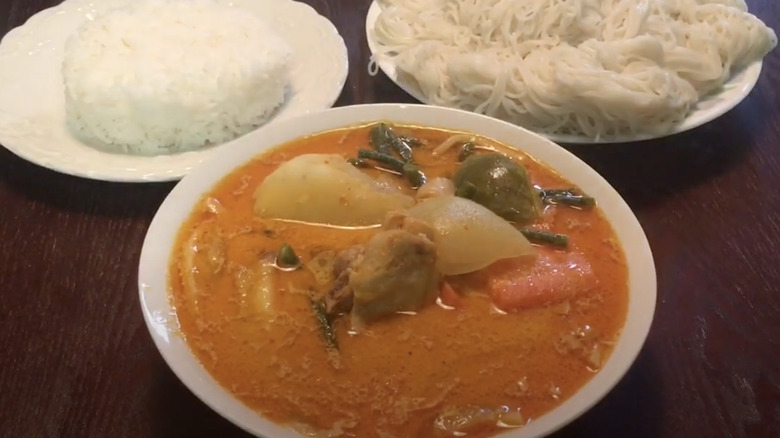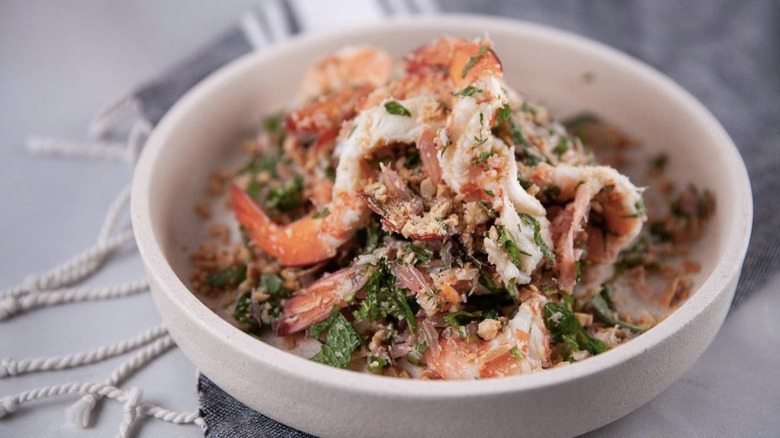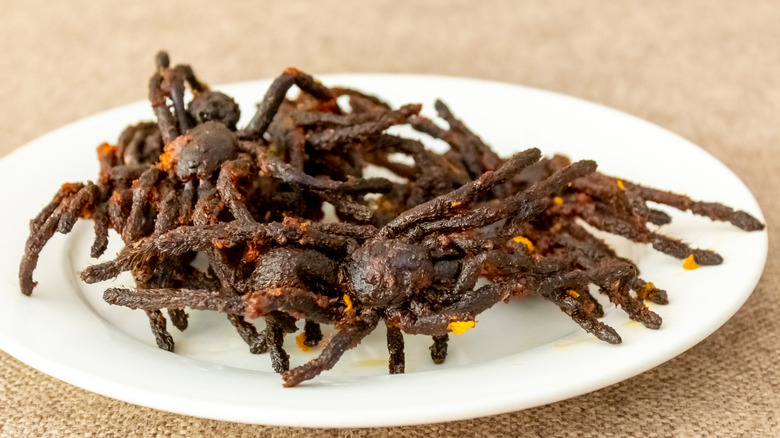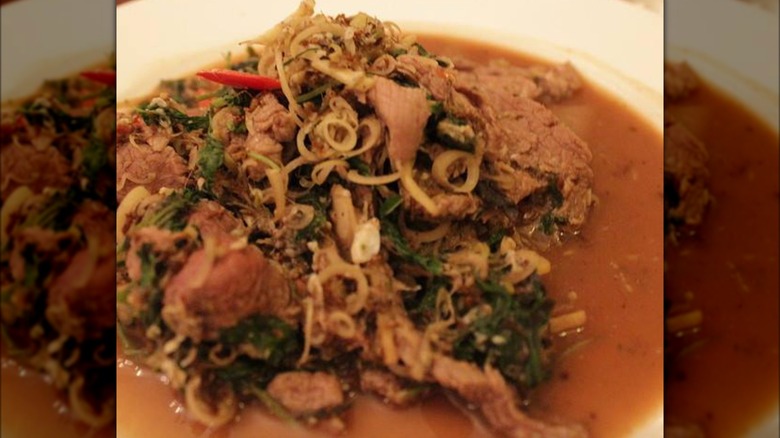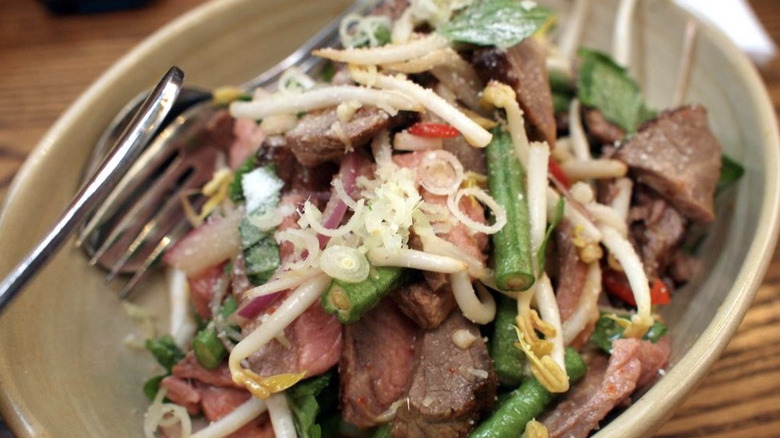Cambodian Dishes You Need To Try At Least Once
Also known as Khmer cuisine, Cambodian cuisine is a fusion of flavors and cooking techniques shaped by the diverse history of this Southeast Asian nation. Whether due to proximity or historical interactions, many Cambodian dishes incorporate a variety of cooking styles, including French, Chinese, Vietnamese, Thai, and Laos.
While rice is the staple food of the country that's typically served with most dishes, Cambodian cuisine is known for its balance of sour, sweet, salty, and bitter flavors, often achieved through the use of herbs, spices, and condiments. Most Cambodian dishes are made with either chicken, pork, or beef, although insects are also sometimes incorporated into meals. Seafood is also prominent in Cambodian cooking thanks to the country's abundant rivers and extensive coastline. Soups, curries, and stews are common, often flavored with lemongrass, Makrut lime leaves, and chilis. The cuisine also features a range of salads, reflecting the country's agricultural heritage.
Ready to learn about the diverse flavors and textures of Cambodian cooking? Take a look at our list of some of the country's most outstanding dishes!
Fish amok
Known as one of Cambodia's national dishes, fish amok is a creamy curry made with kroeung, a Cambodian curry paste that blends spices and herbs like lemongrass, turmeric, Makrut lime leaves, shallots, and chilis. The dish traditionally utilizes fish such as catfish, goby fish, or snakehead fish, but can also be made with other fish types such as salmon or snapper. The fish is then marinated in a mixture of curry paste and coconut cream before being placed in banana leaves and steamed in a cooking technique referred to as amok — hence the name of the dish.
While the exact origins of fish amok are unknown, the dish is believed to draw its roots from the ancient Khmer Empire, a period beginning in the late 8th or in the early part of the 9th century and ending in the 15th century, renowned for its significant influence on the region's cuisine and culture. As the Khmer Empire's influence waned over the centuries, these culinary traditions, including fish amok, continued to be passed down through generations. Today, fish amok remains a beloved staple that can be found on the menus of many Khmer restaurants in Cambodia.
Lok Lak
Uncomplicated yet delicious, lok lak is one of those dishes that lingers in your memory long after the meal has ended. Lok lak's simplicity lies in the preparation process. The beef is first cut into cubes and marinated in ingredients such as soy, vinegar, oyster sauce, and garlic. These cubes are then stir-fried with peppercorns, often using Cambodia's world-renowned Kampot pepper. The beef is usually served on a bed of ripe tomatoes and crispy lettuce, topped with raw white onions or scallions. Finally, the dish is completed with a sauce made from salt, pepper, and lime juice.
Lok lak is sometimes referred to as "shaking beef" in a nod to its Vietnamese counterpart, bò lúc lắc. This highlights the similar cooking technique used in both dishes where the beef is vigorously stirred or "shaken" in a wok during the stir-frying process. The name "lok lak" itself might draw its origins from the French term "l'escalope," which refers to thinly sliced meat.
Kampot pepper crabs
Kampot pepper has gained international acclaim for its outstanding quality and flavor profile. Grown in the Kampot Province of Cambodia, this pepper distinguishes itself with its unique taste, ranging from spicy to sweet. Notably, the spice has earned a prestigious spot in the EU's register of protected designations of origin.
While Cambodian crabs are renowned for their tender, flavorful meat, what truly sets them apart is the use of Kampot pepper stalks in their preparation. As such, it's not surprising that Kampot pepper crabs are one of the country's most sought-after delicacies. In fact, many tourists travel to the crab market in Kep on the southern coast of Cambodia to sample the dish close to its point of origin.
Kampot pepper crabs are prepared by stir-frying the tasty crustacean with various herbs and spices. Aside from Kampot pepper stalks, these typically include a medley of scallions, garlic, and chili for an extra kick. Sometimes a little tamarind paste or lime juice is also added to the dish to imbue it with additional flavor.
Samlor machu
Known for its sour taste, samlor machu is made with chicken, pork, or fish. The soup's distinct tangy flavor is derived from tamarind paste and acidic veggies like tomatoes or pineapple. While it may not be as well known internationally as some other Asian soups such as Vietnamese pho and Thai tom yum, samlor machu is ubiquitous in Cambodia where it's beloved for its refreshing taste.
Rather than referring to one distinct dish, samlor machu encompasses a variety of soups that share the common characteristic of a sour broth. This category of Cambodian soups includes several variations, each with its unique ingredients and regional influences. These include samlor machu moun, a sour chicken soup with pickled lime; samlor machu kroeung, featuring kroeung paste, beef tripe, beef ribs, and coriander; samlor machu Khmer krom, with catfish, holy basil, and lotus root; and samlor machu Siem Reap, with freshwater shrimp and bamboo shoots.
Twa ko
Celebrated worldwide for their rich flavors, sausages are a staple of many culinary cultures, and Cambodia is no exception. Twa Ko are traditional Cambodian sausages that play an important role in the country's gastronomic landscape. The sausages are typically grilled, which makes them a popular choice for both street-side meals and special occasions.
Twa ko are commonly made with either beef or pork, or a mixture of both meats. While recipes for the dish vary, twa ko are commonly made with a blend of rice, galangal, garlic, oyster sauce, and fish sauce. Some versions of the sausages also contain chilis for an extra burst of heat. Once mixed, the ingredients are stuffed into natural casings made from pork intestine, and the casings are twisted to form small sausages. Interestingly, the sausages are sometimes deliberately left out in the sun or allowed to air-dry, as this is thought to help merge the flavors inside the casing.
Bai sach chrouk
Simple yet flavorful, bai sach chrouk is a combination of pork and rice. In Cambodia, this uncomplicated dish is typically enjoyed for breakfast. In fact, you'd have a hard time finding a vendor that sells this meal at lunch or dinner time. As Cambodians often start their day early, those who eat their breakfast late might also miss out on this morning staple.
The pork in bai sach chrouk is marinated in a blend of ingredients such as coconut milk, fish sauce, soy sauce, palm sugar, and Kampot pepper. This combination adds a sweet and savory flavor to the meat. Meanwhile, the palm sugar ensures golden caramelization, enhancing the dish's depth of flavor. The pork is traditionally grilled over charcoal, which gives it a distinct smokiness and tenderness. Finally, the meat is sliced and served with rice and pickled vegetables such as carrot, cucumber, and daikon. A small bowl of broth is also frequently included as a part of the meal.
Kuy teav
For many, breakfast is the most important meal of the day. As such, it's only fitting that Cambodians often start their days with a hearty soup. Known for its rich and flavorful broth, kuy teav is a noodle soup typically made with a clear broth and rice vermicelli. Notably, kuy teav is also popular in neighboring Vietnam, where it's sold as hủ tiếu nam vang or Phnom Penh noodle soup — Phnom Penh being the capital of Cambodia.
The broth for kuy teav can be prepared in a variety of ways. For instance, kuy teav sach moan is made with chicken, kuy teav sach chrouk is made with pork, and kuy teav sach ko is made with beef. All versions of the broth are infused with fragrant herbs and spices. Aside from noodles and meat, some of the typical ingredients found in kuy teav include hard-boiled eggs, bean sprouts, cilantro, and green onions. A key aspect of kuy teav is its condiment customization, allowing diners to adjust the flavor of their soup with additions like fish sauce, lime juice, soy sauce, sugar, and chilis.
Samlar kari
Southeast Asian countries are renowned for their curries, each boasting its own take on the dish, tailored to local tastes and available ingredients. Some of these include Indonesia's rendang, Thailand's massaman curry, and Singapore's fish head curry. Cambodia also has its own rendition of the dish called samlar kari.
Usually made with chicken, beef, or fish, samlar kari, also sometimes referred to as samlor kari, blends coconut milk with various spices. In Cambodia, the term samlar is used for both soup and stew, which can get a little confusing. It's worth noting that certain versions of samlar kari may be a little more watery than the standard curries we are familiar with. While recipes for samlar kari differ, most call for coconut milk, lemongrass, kroeung (a Cambodian mix of spices and aromatics), snake beans, bamboo shoots, potatoes, onions, and eggplant. Chili is also sometimes added for heat, though the level of spiciness can vary.
Nhoam krauch thlong
Appreciated for their distinct blend of sweet and tangy notes, pomelos are both flavorful and refreshing on their own. While the idea of using pomelos in a salad may sound a little unusual, the fruit is commonly added to a variety of dishes in Southeast Asia. A notable example of such a dish is nhoam krauch thlong.
A perfect complement to main dishes like stir-fries and stews, nhoam krauch thlong combines sweet and juicy prawns with the citrusy flavor of pomelo. While the dish is technically a salad, it doesn't contain the typical vegetables one might expect in such a dish. Instead, nhoam krauch thlong blends textures and flavors that are quintessentially Cambodian. Aside from segments of pomelo and prawns, the salad dish also typically comes with dried shrimp, chopped mint leaves, roasted peanuts, and toasted coconut. The salad dressing is usually made with lime juice, fish sauce, a little palm sugar, chili, and garlic, and ties the whole dish together with its sweet, sour, spicy, and salty notes.
Fried tarantulas
While you might be hard-pressed to find fried tarantulas at a restaurant in the center of Cambodia's capital, Phnom Penh, the country is well known for this unusual specialty. The fried creepy crawlies are particularly popular in the town of Skuon, around 50 miles from Phnom Penh, where they are often sold at roadside stalls. In fact, few tourists pass through the town without trying the famous snack.
The practice of eating tarantulas in Cambodia is believed to have started in the 1970s during the harsh times of the Khmer Rouge regime. With widespread food shortages, the country's population had to depend on whatever sources of nourishment they could find, including insects and spiders.
Featuring a crispy exterior and a soft and chewy interior, fried tarantulas can be an acquired taste. Before being fried, the tarantulas are seasoned with a mixture of sugar, salt, and crushed garlic. It's the quick deep-frying process that makes the tarantula's exterior and legs so crispy without overcooking its gooey interior.
Ongkrong saek koo
Characterized by their reddish-brown bodies and large colonies, red tree ants are probably the last thing you would normally expect on your dinner menu. In Cambodia, however, red ants are used to add texture and flavor to various dishes. One such dish is ongkrong saek koo, a specialty made with beef and holy basil that showcases the culinary creativity of this colorful country. Notably, many other Cambodian dishes also include insects, such as crickets and grasshoppers. The country's culinary landscape also features scorpions, water bugs, grubs, and maggots.
Ongkrong saek koo combines the slightly sour and tangy flavor of red ants with the robust taste of thinly sliced beef. There's a chance that diners might also find themselves enjoying ant larvae. To add flavor, the stir-fried dish is commonly infused with a blend of herbs and spices, such as garlic, chili, shallots, lemongrass, basil, and chilis.
Lap Khmer
Lap is the national dish of another Southeast Asian country — Laos. The term refers to the minced meat that's incorporated into the dish. Despite its origins, lap is also commonly eaten in Cambodia and Thailand. Sometimes referred to as a minced beef salad, lap Khmer is beloved for its fresh ingredients and harmonious blend of flavors. While lap Khmer can be served as a side dish, it's also frequently enjoyed as an appetizer or even a main dish.
Also sometimes called pleah sach ko or nhoam sach ko, lap Khmer incorporates minced or thinly sliced beef, which is either lightly seared or served nearly raw. It is also sometimes cured in lime juice. While typically prepared with beef, lap Khmer is also sometimes made with other proteins, such as pork, chicken, or fish. Some other ingredients used to add flavor to the dish include garlic, lemongrass, chilis, fish sauce, and a fermented fish paste called prahok. Lap Khmer also normally comes with long green beans and bean sprouts.
